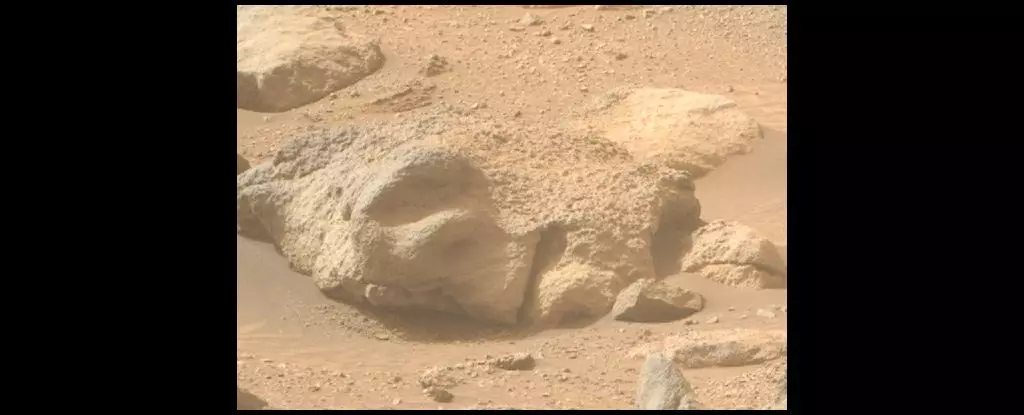The phenomenon known as pareidolia presents an intriguing glimpse into the human psyche and our innate tendency to assign meaning to the ambiguous. Recently, images transmitted from Mars have reignited interest in this psychological quirk, especially following the discovery of a rock that strikingly resembles a decaying human head. Captured by NASA’s Perseverance rover on September 27, 2024, this image sent shockwaves through both scientific and public communities. While some observers may have initially been thrilled—or horrified—at the semblance of human remains on the red planet, the truth behind this geological curiosity is far less dramatic.
Mars is notorious for its enigmatic landscapes and curious formations, ranging from towering volcanoes to deep canyons. Among these, the piece of sedimentary sandstone that caught the eye of the rover’s cameras is a testament to the power of wind and water erosion over millennia. It’s crucial to acknowledge that this rock, despite its uncanny resemblance to a human visage, is purely a geological formation. The angle of the photograph, combined with the peculiar weathering patterns of the rock, gives rise to an illusion shaped by pareidolia—a phenomenon that compels our brains to make connections where none exist.
Mars has long been a rich source of inquiry and intrigue for scientists and non-scientists alike. Its desolate beauty and historical implications of potentially harboring life lead humans to ponder their own existence in the universe. The idea that a rock can evoke thoughts of a severed head highlights not only our fascination with the cosmic but also the psychological comforts we seek through familiar forms. This highlights a compelling intersection of geology, psychology, and philosophy—demonstrating how human perception can distort reality and fuel our imaginations.
Human brain mechanisms are intricately designed to recognize faces and create patterns; an ability that plays a pivotal role in social interaction. The fusiform gyrus, a critical area in our brain for facial recognition, often triggers this identification process impulsively, even in distinctly non-human contexts. This neuropsychological instinct explains why so many images from Mars have been interpreted as recognizable shapes, including faces of animals and human-like figures.
Instances of pareidolia extend far beyond Martian rocks; examples abound here on Earth. From the famous ‘Badlands Guardian’, a land formation in Canada likened to a human head, to apparent faces found in clouds or on single grains of sand, the world is teeming with optical illusions that reveal the capabilities—and limitations—of human perception. The ‘Google Faces’ project catalogues various landscapes that evoke facial imagery, showcasing how widespread this phenomenon is across different contexts.
The inclination to ascribe meaning to the unintentional is a testament to humanity’s quest for connection, compelling us to draw narratives from fragments of reality. However, it simultaneously evokes a cautionary stance; the danger lies in mistaking illusion for reality. This same caution must be applied to our explorations of Mars as we endeavor to seek out life beyond Earth. Speculation is exhilarating, but the evidence remains clear: no complex life forms have been found on the red planet, merely geological structures that inspire human imagination.
As humanity prepares for future manned missions to Mars, the excitement surrounding extraterrestrial exploration is palpable. The intersections of science fiction and reality create a realm of possibilities, from finding evidence of life to encountering unexplained phenomena that may bewilder future explorers. As we advance our technologies and deepen our understanding of Mars, it’s essential to maintain a balanced perspective. The rock that resembled a human head symbolizes both the marvel of geological formations and the limitations of our perception.
The peculiar image captured by the Perseverance rover serves not just as a mere curiosity but as a mirror reflecting the fascinating interplay between human cognition and the cosmos. It challenges us to explore beyond initial appearances and encourages a healthy skepticism as we chart the paths of our explorations into the unknown. As we continue to endeavor into the depths of space, we may leave behind our own enigmatic creations for the next explorers—whatever form they may take.



Leave a Reply